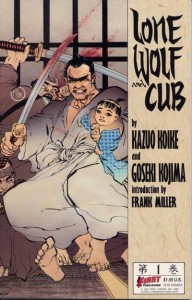Samurai have long held an iconic position in Japan, as have the various depictions of this pre-industrial military nobility. From stoic swordsman in attentive service to the aristocracy to post-modern and futuristic robotic warrior, the samurai has established itself as a paragon of duty, honor, and service.
Drawing the Sword: Samurai in Manga and Anime explores the changing face and interpretation of the samurai as seen through two of Japan’s most creative and expressive artistic forms. Now on display at the Cartoon Art Museum (in the heart of San Francisco’s South of Market museum district), the exhibition traces this evolution from historic 19th century woodblock prints to leading-edge 21st century animation production cels and drawings.
Along the way, we see a series of favorites ranging from Usagi Yojimbo and Rurouni Kenshin to Evangelion and Gundam. All are impressive and go a long way in helping us understand the shifting perception of this heroic class.
From early masters to cutting edge
The depiction of the samurai starts, chronologically, with Utagawa Kuniyoshi’s full color woodblock print Kanai Tanigoro Fighting the Dragon at Samegai. Woodblock printing, or ukiyo-e, was popular in Japan between the 17th and the 20th centuries, in part because the medium lent itself to a limited form of mass-production. This, combined with Japan’s increasingly-urbanized population, opened the art form to many who, in general, were not wealthy enough to afford original paintings.
Two additional ukiyo-e by Tsukioka Yoshitoshi, Earth Spider (1880) and Li No Hayata Kills the Nue at the Imperial Palace (1890) further illustrate the Japanese woodblock print tradition. A student of Kuniyoshi, Yoshitoshi today is widely recognized as one of the greatest innovators of the genre and perhaps its last great master.
Spanning the end of the Tokugawa Shogunate and the beginning of the Meiji Restoration, Yoshitoshi railed against the increasing displacement of the traditional for the modern in Japan including the shunning of ukiyo-e for the more easily distributed Western art forms including photography and lithography.
As the popularity of ukiyo-e faded, so too did the appreciation of Yoshitoshi’s incredible contribution — until the end of the 20th century that is. Today Yoshitoshi is recognized as a master artist and creative genius.
The concept of samurai has continued to evolve in Japan throughout the 20th century, resurfacing in popular expression to match the subconscious mood of the nation. More recent samurai depictions on display in the exhibition, for example, include a series of animation production cels (cellulose acetate and paint) with associated ink on paper drawings highlighting works ranging from Samurai Troopers? by Hajime Yatate, Jubei Chan by Akitaro Daichi, Rurouni Kenshin by Nobuhiro Watsuki, and the ultra-futuristic Gundam by Sunrise Studios.
For a completely different take on the samurai, manga fans will be pleased to see several examples of Stan Sakai’s highly-acclaimed Usagi Yojimbo. Set at the start of the Edo period (early 17th century), Usagi Yojimbo (which translates literally to rabbit bodyguard) follows rabbit ronin Miyamoto Usagi, based partially on the legendary swordsman and samurai Miyamoto Musashi, known for his exemplary form and style.
Usagi Yojimbo, which made its debut in 1987 as a comic book series, draws on several sources for inspiration including the acclaimed cinematic works of Japanese director Akira Kurosawa (from whose film Yojimbo, the book series draws its name). Usagi Yojimbo’s deft anthropomorphic styling and rich historic themes have garnered Sakai numerous awards and remain popular to this day.
In the end, Drawing the Sword: Samurai in Manga and Anime offers a tightly-focused and enlightening exposition of perhaps the singularly most commanding and enigmatic figure in Japanese history: a figure which remains only slightly submerged within the greater Japanese psyche.
Plan Your Visit
Drawing the Sword: Samurai in Manga and Anime is on display at the Cartoon Art Museum until May 2nd.
Cartoon Art Museum
655 Mission Street
San Francisco, CA 94105
(415) 227-8666
www.cartoonart.org

